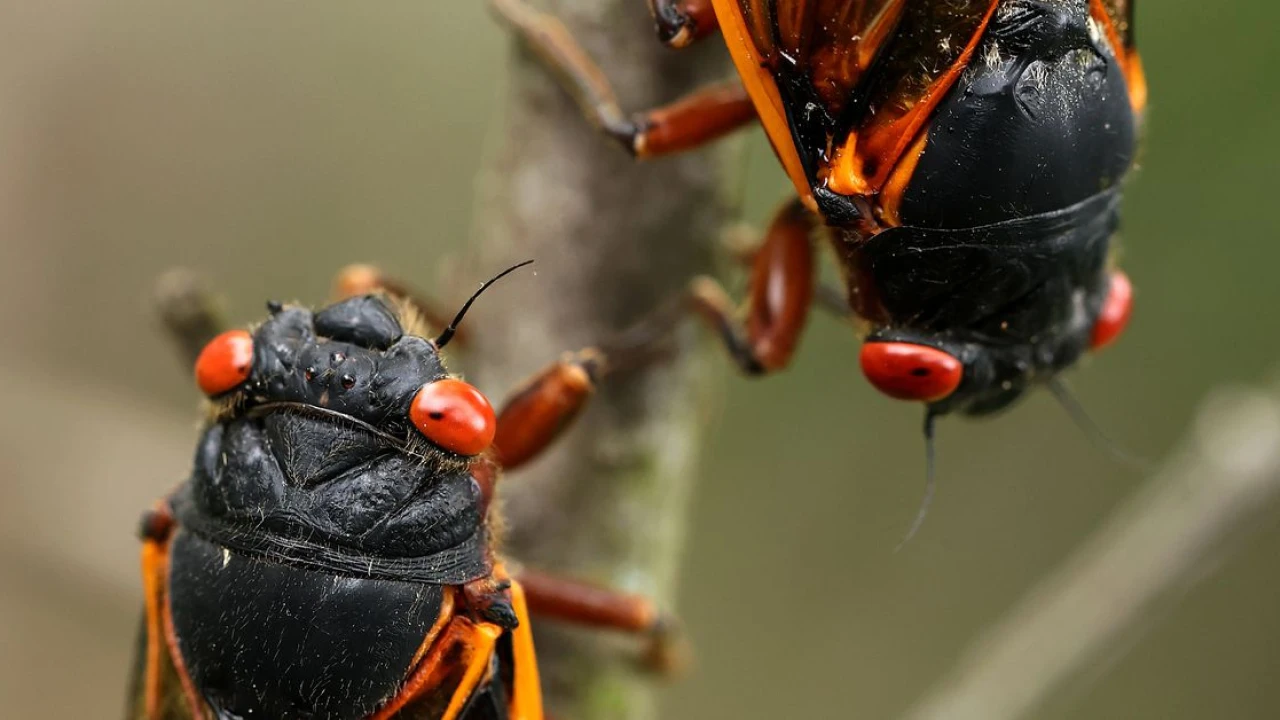Regional
A rare burst of billions of cicadas will rewire our ecosystems for years to come
From Chicago to South Carolina, swarms of noisy periodical cicadas will rewire forest food webs.

This spring is a very good time to be a bird.
In forests across the Midwest and Southeast, the ground is about to erupt with billions of loud, protein-packed cicadas. They’ll buzz about for a few weeks as they search for mates, providing snacks for pretty much every living creature in the forest, from songbirds and swans to frogs and even fish.
This is an especially big year for these red-eyed bugs: Brood XIX and Brood XIII — which pop up every 13 years and 17 years, respectively — are emerging at once. The last time such an event happened was the spring of 1803, when Thomas Jefferson was president. It will be hundreds of years before it happens again.
While the insect explosion will be brief, it will shape forests for years to come. The binge-fest that birds enjoy during these periods supersize their families and, in turn, shift the eating and hunting patterns of many other species. These effects send ripples throughout the ecosystem. As one recent study put it, pulses of periodical cicadas can “rewire” entire forest food webs. Call it the butterfly cicada effect.
Why billions of cicadas erupt all at once
For most of their lives — either 13 or 17 years, depending on the brood — periodical cicadas live several inches underground, slurping up sap from plant roots with their straw-like mouths. Then, when the soil temperature hits about 64 degrees Fahrenheit, they emerge, typically after sunset. Cicadas in more southern states, like Alabama, usually emerge in April or early May, whereas those in colder states like Illinois tend to appear later in the spring.
The teenage insects then march up plants, trees, and fences, where they metamorphose into winged adults. That’s when giant groups of males start singing loudly to attract females (you know, lady bugs). During these events, a single acre of land can have more than 1 million cicadas on it. That’s roughly 2,700 pounds of bugs.
:no_upscale()/cdn.vox-cdn.com/uploads/chorus_asset/file/25432087/GettyImages_2150500394.jpg)
:no_upscale()/cdn.vox-cdn.com/uploads/chorus_asset/file/25432091/GettyImages_2150469251.jpg)
This mass eruption, scientists believe, is strategic. “They effectively satiate their predators,” Louie Yang, an entomologist at the University of California Davis, told me a few years ago, when the famous Brood X emerged.
The cicada defense strategy is to flood the forests so that predators become so full they literally can’t stomach another bite. That leaves plenty of insects left to mate and lay eggs that will become the next generation of cicadas.
This approach seems to work for cicadas, and it’s an absolute delight for birds.
Birds lose their minds during cicada outbreaks
Birds can be fussy about their food. Some prefer plants, like the trumpeter swan, while others specialize in seeds or small insects, like chickadees.
Those preferences get tossed out during cicada explosions. The birds stop what they’re doing and go to town on the bug buffet. During the Brood X emergence in 2021, researchers documented more than 80 different avian species feeding on cicadas, including small birds that couldn’t fit them in their mouths.
:no_upscale()/cdn.vox-cdn.com/uploads/chorus_asset/file/25432103/Grackle_eating_a_cicadaIMG10284_ByDan.jpg)
“We saw chickadees — tiny, tiny little birds — grab the cicada and drag it to the ground with their body weight and then peck it apart,” said Zoe Getman-Pickering, an ecologist at University of Massachusetts Amherst, who led the research.
She also saw purple martins, which typically catch small insects like winged ants and flies from the air, go after loads of cicadas. “There was one family of purple martins that got 23 cicadas into their nest in three hours or so,” Getman-Pickering said.
This feeding frenzy can seriously benefit some birds. Simply put, more food can lead to more babies.
“Following emergences, you do tend to get an increase in a lot of the apparent avian predator populations,” Walt Koenig, an ornithologist at Cornell University and research zoologist emeritus at UC Berkeley, told me in 2021.
One analysis he co-authored, based on 37 years of data, linked cicada eruptions to a population bump in a number of species including red-headed woodpeckers and common grackles.
Remarkably, many of these knock-on effects lasted for years, Koenig said. The number of blue jays, for example, was significantly higher even three years after the cicada eruptions.
“These results indicate that, at least in some species, the effects of cicada emergences are detectable years after the event itself,” Koenig and his co-authors wrote.
Fat caterpillars, rejoice
It’s not just birds that are benefitting. During big emergences, avian predators are eating so many cicadas that they eat much less of everything else — including caterpillars. That means caterpillars get a rare reprieve from the constant threat of attack, at least from birds.
Researchers have actually measured this. In the years surrounding Brood X, Getman-Pickering and her collaborators filled forests in Maryland with fake caterpillars made of clay. They then measured how many of them had signs of bird strikes — beak marks indicating that birds tried to eat them.
:no_upscale()/cdn.vox-cdn.com/uploads/chorus_asset/file/25432098/Copy_of_clay_caterpillar_with_bird_beak_marks_IMG_4269_ByMartha.png)
In May, when Brood X was emerging, the portion of caterpillars with strike marks fell dramatically, from about 30 percent in a typical year to below 10 percent during the emergence, according to her study, published in 2023.
She also looked at real caterpillars. Remarkably, the number of them roughly doubled in the forests she studied during the emergence, relative to the two following years. “It was pretty staggering how many caterpillars that we saw,” Getman-Pickering said.
A lot of them were extra plump, too, like the spiny larvae of the dagger moth. When there are few cicadas, the juiciest caterpillars are often picked off first; they’re much easier for birds to spot. But during cicada eruptions, caterpillars are free to eat and grow at their leisure.
“The biggest, most visible caterpillars benefited immensely from the release from predation,” she said.
:no_upscale()/cdn.vox-cdn.com/uploads/chorus_asset/file/25432100/Acronicta_caterpillar_on_oak__by_John.JPG)
Trees might prefer life without cicadas
A surge in caterpillars, meanwhile, has effects of its own. These animals famously eat leaves. So when birds eat fewer of them, the caterpillars chew their way through more of the forest canopy.
Getman-Pickering’s recent study measured this too: In the summer of 2021, after Brood X debuted, oak trees experienced “a spike in cumulative leaf damage,” the paper states. A doubling of the number of caterpillars meant a doubling of the damage, she said.
It’s not clear what that ultimately means for forest health. Previous studies have shown that cicadas themselves, however, can harm trees. After breeding, females carve slits into branches and lay eggs, which often damages the wood.
Research by Koenig, of Cornell, found that oak trees produced fewer acorns in a year with a cicada emergence, and in the following year. Older studies have also shown that emergences can slow the rate of tree growth.
The long-term picture is hazier. Unpublished data from Karin Berghardt and Kelsey McGurrin, researchers at the University of Maryland, shows that trees seem to bounce back from the harm caused by egg-laying. There’s also some research suggesting that cicada carcasses could actually fertilize the forest floor.
Ultimately, what all of these studies show is that cicadas can transform entire ecosystems in just a few short weeks. Think about that the next time you walk through the woods: The birds, the butterflies, the trees themselves are all shaped, in some way, by one very weird bug.
Business
Per tola gold prices remain unchanged in Pakistan
The price of the yellow metal stood at Rs239,200 per tola

Karachi: Gold prices remained unchanged in the country on Thursday after dropping Rs800 per tola on Wednesday. The price of the yellow metal stood at Rs239,200 per tola.
The 10 grammes gold was sold at Rs205,075, according to the rates shared by the All Pakistan Gems and Jewellers Sarafa Association (APGJSA).
The international rate of gold remained intact on Thursday. As per APGJSA, the rate was $2,312 per ounce (with a premium of $20).
Meanwhile, silver rates remained stable at Rs2,620 per tola. Last month, gold hit an all-time high of Rs252,200 per tola in the local market.
Gold in tight range with US economic data on tap
Gold prices hovered in a tight range on Thursday as investors turned their attention to US economic data that could offer additional insights into when the Federal Reserve might implement interest rate reductions.
Spot gold rose 0.2% at $2,314.26 ounce, as of 0456 GMT. US gold futures lost 0.1% to $2,321.00. The US weekly jobless claims data is due at 1230 GMT and the University of Michigan’s consumer sentiment reading on Friday.
The consumer price index data is scheduled to be released next week. “Despite market expectations of a rate cut in September, gold traders are cautious about making big moves … If US inflation report comes hotter then prices could fall to $2,290,” said Ajay Kedia, director at Kedia Commodities, Mumbai.
According to the CME’s FedWatch Tool, traders are currently pricing in about a 66% chance that the Fed will cut rates in September.
Lower interest rates reduce the opportunity cost of holding bullion.
Fed Bank of Boston President Susan Collins said on Wednesday that the US economy needs to cool off to get 2% inflation. China’s exports and imports returned to growth in April, signalling an encouraging improvement in demand at home and overseas.
“Looking ahead to the rest of 2024, the outlook for gold remains relatively positive,” ACY Securities analyst Luca Santos said. “There’s even potential for it to break above $2,500, especially if economic conditions remain uncertain and geopolitical tensions persist.”
Palestinian militant group Hamas said on Wednesday it was unwilling to make more concessions to Israel in negotiations over a ceasefire for Gaza. Meanwhile, spot silver gained 0.7% to $$27.53 per ounce.
“Long-term view on silver remains positive. It can climb to $30 in the fourth quarter,” Kedia said. Platinum advanced 0.8% at $982.10 and palladium firmed 0.5% to $956.13. Johnson Matthey said in a report that the platinum market faces its largest supply shortfall in 10 years in 2024.
Additional input from Reuters
Sports
Italian tennis star Giorgi retires, federation announces
Camila Giorgi most recently played in the second round at the Miami Open in March

Rome (AFP): Italian tennis player Camila Giorgi, a four-time winner on the WTA circuit, has retired at the age of 32, Italy's tennis federation (FITP) has announced.
Giorgi most recently played in the second round at the Miami Open in March when she was swatted aside in straight sets by world number one Iga Swiatek.
She made no personal announcement of her retirement, the FITP releasing a short statement on Wednesday saying that Giorgi "has said goodbye to tennis".
Meanwhile the International Tennis Integrity Agency, the game's anti-corruption and doping watchdog, lists Giorgi as having retired on Tuesday.
Among Giorgi's four WTA tour wins was her Masters 1000 title at Montreal in 2021, while she peaked at 26 in the world rankings in October 2018.
Her best result in a Grand Slam tournament was a run to the quarter-finals at Wimbledon in 2018, while she reached the same stage at the Tokyo Olympics three years ago.
-

 Sports 2 days ago
Sports 2 days agoPCB introduces T20 World Cup 2024 kit for Pakistan team
-

 Pakistan 2 days ago
Pakistan 2 days agoPPP’s Sardar Salim Haider Khan to take oath as Punjab governor tomorrow
-

 Regional 1 day ago
Regional 1 day agoPunjab Nominee Governor Haider aims to bridge gap between PML-N, PPP
-

 Business 1 day ago
Business 1 day agoGold price drops by Rs800 per tola
-

 Regional 2 days ago
Regional 2 days agoMatric exams in Karachi, Section 144 imposed
-

 Business 2 days ago
Business 2 days agoGold prices in Pakistan fall slightly
-

 Pakistan 1 day ago
Pakistan 1 day agoFees of fast-track passports increase again
-

 Sports 2 days ago
Sports 2 days agoShehla Raza steps down as PHF President





















